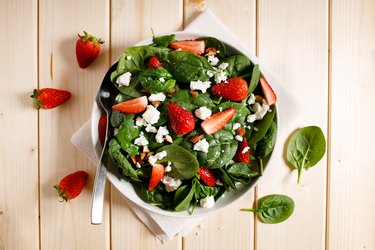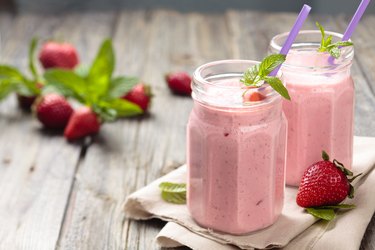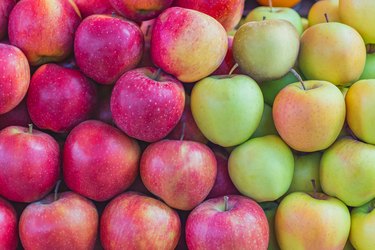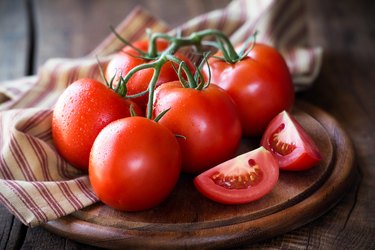
When shopping for vegetables and fruits, the amount of pesticide residue they contain might not be the first thing that comes to your mind.
That's why the Environmental Working Group (EWG) recently released their 2021 Shopper's Guide, which highlights their Dirty Dozen and Clean Fifteen lists, ranking conventionally grown foods with the highest and lowest levels of pesticide residue, respectively.
Video of the Day
Video of the Day
To create these reports, the EWG analyzed data from the U.S. Department of Agriculture (USDA), which regularly tests vegetables and fruits for pesticide residues. Out of the 46 most popular vegetables and fruits that were included in the EWG's analysis, the Dirty Dozen list represents the foods that were contaminated with the most pesticides, while the Clean Fifteen list are foods with the least amount of pesticide residue.
This year's rankings were based on the USDA and Food and Drug Administration's (FDA) analysis of more than 46,075 samples.
One of the most notable findings in this year's report was that kale remains third on the Dirty Dozen, joined by collard and mustard greens. This is largely because the USDA found traces of DCPA, an herbicide under the brand name Dacthal, in the king of greens. The Environmental Protection Agency (EPA) considers DCPA a possible human carcinogen.
Plus, peppers contained the pesticides acephate and chlorpyrifos, which have been banned on some crops but not on hot peppers.
Should You Worry About Pesticides?
While all of these findings are important to know, you should also take them with a grain of salt.
"The EWG looks at whether or not a fruit or vegetable has pesticide residues, but it does not explain to consumers that the presence of residues does not mean that the produce is harmful," Frances Largeman-Roth, RDN, nutrition and wellness expert and author of Eating in Color, tells LIVESTRONG.com.
The EPA also regulates the level of pesticides in foods that's safe to eat. Considering that 95 percent of Americans don't get enough fiber in their diet, according to a 2017 study in the American Journal of Lifestyle Medicine, it's more important that you're eating more vegetables and fruits — whether they're organic or not.
"I definitely support organic farmers, and if people can afford to buy organic, that's a great choice for the planet," Largeman-Roth says. "But the risk that is posed by the very low levels of pesticide residue on conventional produce is infinitesimal compared to the risk of not eating fresh fruits and vegetables, which provide so many disease-fighting compounds," she says.
Use a Pesticide Residue Calculator
Try this pesticide residue calculator from the Alliance for Food and Farming.
"This calculator tells you how much of each type of conventional produce you can eat without having any adverse effects," Largeman-Roth explains. For example, an adult woman can eat 453 servings of strawberries in one day without having any effects — even if the blueberries have the highest pesticide residue recorded for blueberries by the USDA.
Organic vs. Conventional Produce
To be clear, organic produce or food that is organically grown can be produced using pesticides, but unlike conventional produce, these pesticides are derived from natural sources, according to the EPA.
The USDA is the only body of government that certifies organic food, and the National Organic Program is a marketing program within the USDA that sets these standards for prohibited substances.
If you're concerned about high exposure to pesticides, purchasing organic counterparts of the Dirty Dozen might be worth your dollar if you can afford it.
Foods with the USDA organic certification mean that they are free of synthetic pesticides and genetically modified organisms (GMOs). So while you'll still be exposed to pesticides in organic produce, they aren't harmful to your health.
An April 2019 study in Environmental Research suggests that an organic diet may help reduce pesticide exposure in children and adults. The study involved collecting urine samples from 16 participants from four different areas of the U.S. and testing them for insecticides, herbicides and fungicides. Researchers found that an organic diet helped reduce exposure to neonicotinoids and pyrethroid, among other insecticides.
Research has also shown that organic produce might boast more health-boosting antioxidants than their conventionally grown counterparts. A landmark July 2014 meta-analysis in the British Journal of Nutrition based on 343 peer-reviewed publications, shows that organic produce has higher concentrations of antioxidants and beneficial compounds than conventional produce.
The same meta-analysis also showed that the amount of pesticide residue in conventional crops is four times higher than in organic produce. But again, these findings are small compared to the larger picture of eating more vegetables and fruits in general.
"Again, if people can find and pay for organic, that's awesome, but don't avoid your favorite fruits because you can't pay for the organic version. We're not eating enough produce as it is. Only nine percent of American adults get enough veggies and just 12 percent of us eat enough fruit, according to the Centers for Disease Control (CDC)," Largeman-Roth says.
If you're concerned about high exposure to pesticides, purchasing organic counterparts of the Dirty Dozen might be worth your dollar if you can afford it. But if you can't, you're better off eating the conventionally grown foods on the list rather than avoiding them altogether, and here's why.
The Dirty Dozen List
1. Strawberries

This ruby-hued fruit is deliciously sweet and nutrient-dense, making it a great addition to smoothies, yogurt parfaits and homemade baked goods.
Strawberries are packed with vitamin C and contain 3 grams of fiber per cup, Largeman-Roth says. "They also contain folate for a healthy pregnancy, as well as the electrolyte potassium for muscle contractions and a healthy heart," she says.
2. Spinach
There's a reason Popeye ate loads of spinach, and it's because the leafy green is rich in iron. Largeman-Roth says one cup of cooked spinach has 6 grams of iron. Iron helps delivery oxygen to muscle tissue, aiding recovering and reducing fatigue. It's also essential for supporting the immune system.
3. Kale, Collard and Mustard Greens
These greens are packed with beta-carotene, lutein and zeaxanthin, Largeman-Roth says. "They're also high in vitamin K, which is essential for blood clotting," Largeman-Roth says.
4. Nectarines
When summer stone fruit season hits, you definitely want to stock up on nectarines. Largeman-Roth says the fruit provides lutein and zeaxanthin, which are essential for eye health. Chop a few pieces of nectarine and add them to a bowl of Greek yogurt and low-sugar granola for a satisfying breakfast.
5. Apples

Because apples are high in fiber (about 4 grams per fruit), they make a great snack for curbing cravings and stabilizing blood sugar. "It also contains the flavonoid quercetin, which shows promise for its ability to protect brain neurons from oxidative damage, a known cause of Parkinson's and Alzheimer's disease," Largeman-Roth says.
6. Grapes
The bite-sized fruit packs resveratrol, a potent antioxidant with anti-inflammatory properties, Largeman-Roth says. Resveratrol has also been shown to help protect the heart.
7. Cherries
These tiny but mighty fruits are powerful natural sources of vitamin C and beta-carotene. They also boast essential minerals, like iron, calcium and magnesium. "One cup of cherries contains 3 grams of fiber and 342 milligrams of potassium. They also contain phytonutrients that provide their deep red color," Largeman-Roth says.
8. Peaches
Much like nectarines, these stone fruits are good sources of potentially disease-fighting compounds, including quercetin, catechins, anthocyanins and chlorogenic acid, that work to prevent metabolic syndrome, Largeman-Roth says.
9. Pears
Crisp and juicy, pears contain a wealth of nutrients, including vitamins C and K, potassium, copper and manganese. A medium fruit contains 5.5 grams of fiber, which help you feel full and support healthy digestion, Largeman-Roth says.
10. Bell and Hot Peppers
Bell peppers have more than double the vitamin C than oranges, according to the USDA. Chop them up and toss them over salads for a healthy crunch.
11. Celery
This crunchy veggie has become more popular recently, thanks to the celery juice fad on social media. While the juice supplies some nutrients, eating the whole vegetable provides fiber, too. One cup of celery provides 1.6 grams of fiber, plus 40 milligrams of calcium and 263 milligrams of potassium.
12. Tomatoes

If you want to infuse some vibrance to your salads, fresh tomatoes not only add juicy flavor but they supply fiber and the antioxidant lycopene. Lycopene has been associated with a lower risk of certain types of cancer, including prostate, lung and stomach, Largeman-Roth says.
- The Environmental Working Group's 2020 Shopper's Guide to Pesticides in Produce
- U.S. Environmental Protection Agency Office of Pesticide Programs: "Chemicals Evaluated for Carcinogenic. Potential Cancer Annual Report 2018."
- Alliance for Food and Farming: Pesticide Residue Calculator
- U.S. Environmental Protection Agency: "Organic Farming"
- U.S. Environmental Protection Agency: "Food and Pesticides"
- American Journal of Lifestyle Medicine: "Closing America's Fiber Gap."
- U.S. Department of Agriculture: "Organic Labeling"
- Environmental Research: "Organic Diet Intervention Significantly Reduces Urinary Pesticide Levels in U.S. Children and Adults."
- British Journal of Nutrition: "Higher Antioxidant and Lower Cadmium Concentrations and Lower Incidence of Pesticide Residues in Organically Grown Crops: A Systematic Literature Review and Meta-Analyses."
- Centers for Disease Control and Prevention: "Only 1 in 10 Americans Get Enough Fruits and Vegetables."